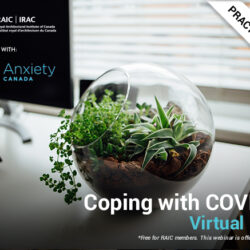This website uses cookies so that we can provide you with the best user experience possible. Cookie information is stored in your browser and performs functions such as recognising you when you return to our website and helping our team to understand which sections of the website you find most interesting and useful.
RAIC Catalyst For Change – Allison Gonsalves

September 2023
To celebrate and honour RAIC volunteers, we are pleased to introduce you to Allison Gonsalves, OAA, MRAIC, M.ARCH, B.EDS and member of the RAIC Promoting Equity and Justice Committee.
Thank you, Allison!
Why did you decide to become an architect?
I became an architect by chance. With my family being from the West Indies, my knowledge of architecture was limited and based in practicality based on our weather and environment. I always had a passion for art and design in high school. Against my family’s better judgement, I attended a post-secondary art and design school, which offered courses in architecture and interior design. These courses opened my eyes to thinking creatively in three dimensions. I became very excited to learn about a profession that pushed me artistically and rigorously. After convincing my parents that studying architecture as my major would lead to a successful profession, I struggled as the only person of colour in my class. I worked twice as hard to keep up and had to re-train my mind to think about design differently. I started to design with my heart vs. what the textbooks were teaching. I chose to do my master’s in architecture and ended up in a school that supported equity and provided equal opportunities. This environment helped me realize architecture wasn’t just about buildings, it was about people, integration, acceptance, comfort, and beauty. Architecture became about designing for a person’s soul, and creating spaces that people can relate to in meaningful ways. You don’t always get this opportunity in a project, but the challenge to design thoughtful and connective spaces for people and communities became a driving force on why I wanted to become an architect.
How long have you been an RAIC member and what do you see as the value of your membership?
I became an RAIC member 3 years ago because I wanted to apply to be a member of the new Promoting Equity and Justice Advisory Committee (PEJ-AC). It is essential that there is Canadian representation in architecture that sets a positive and meaningful example for the profession and leads the way in change. There is great value in the RAIC committees because they can provide opportunities and resources for bettering the architecture profession in Canada. My membership is valuable because the RAIC offers opportunities to make positive change within our profession. As a small business owner, being a member gives me access to contracts that I may not be aware of otherwise.
Why do you volunteer for the RAIC?
Being a woman of colour in the architecture profession has been challenging. Biased points of views and discrimination are alive and felt in architecture. I volunteer for the RAIC because they provide an outlet for positive change. The RAIC listens and wants to do better. It is an organization that strives to learn and educate. They are dedicated to their volunteers and invest time and energy into creating a profession that is inclusive and respectful.
What do you find most challenging about working as an architect?
Architecture is challenging because there are always limits. As an architect, it is not often that there is a budget or a client that is willing to invest in a building that is inclusive to all people or respectful to our environment. In most cases, this is not an option. The National Building Code provides minimum standards that do not allow equity for all people or for our environment. These standards should not be a choice, and it is challenging to design a building knowing that it is not representing the future positively.
Why is the area of advocacy important to you?
Advocacy is important to me because I have lived experience. I have lived through discrimination, stereotypes, and biases. I became an architect so that I could make positive changes though designing spaces but realized that there were invisible limits that I couldn’t see, but I could feel. Architecture was either pushing people of color out or not inviting them in. I wanted to educate youth about the profession so that they can have knowledge about the profession in a way that I did not. Empowering students of color can inspire them to change their communities and advocate for a built world that is inclusive. It is important for me to also advocate for change within the profession so that we make space to retain and be respectful of architects of color entering the profession.
What do you think will most change/shape practice over the next five years?
I think the promotion of equality and inclusivity within practices are shaping change currently and will continue over the next 5 years. Many firms have created mandates for change; to reflect a 50/50 split in gender representation, to hire and promote people of colour, and to unlearn biases that practices have had embedded within them for many years.
What role do you see the RAIC and architects playing in terms of climate action, truth and reconciliation, and procurement reform, among other issues that matter?
Change takes a long time. It is my opinion that the RAIC and many architects think very strongly about bringing positive change to issues that matter. I have always believed that if there is a will to create good change, and there is a plan, then change will come. It won’t come overnight. Issues for betterment will always be sustained if we advocate for them. Once we stop advocating, the issues will dissolve. The RAIC is a leader that can provide willing architects with a place to become involved in matters that are important to them. Being an advocate and a resource is a meaningful role and one that will allow progress in our profession. We are only one piece of the puzzle. Change happens when there are many willing hands. Working with lawmakers, developers, etc. is essential and it’s our role to invite the other disciplines to the table and have a conversation.
What advice would you have for those looking to get more involved in advocacy causes related to architecture?
The advice I always give is not to give up on the issues that are meaningful to you because then you are giving up on yourself. There is always room for good change, and we can do better for our future generations in this profession. Advocacy in architecture may seem daunting when you are not a part of a group, but it’s not always about the size of the army but more about the willingness of the spirit. Advocacy in architecture can take place in many ways and with small steps such as getting involved in your community, with your local lawmakers, with the youth, within schools, or within your office. In addition, there are numerous architecture advocacy groups within the community that are always looking for another positive voice.
How do you incorporate diversity, equity and inclusion in your work environment, the built environment and your volunteer work?
In my office, I have mentored women of color, provided opportunities and positive guidance based on my experience within the architecture profession. In my volunteer work, my firm has been able to partner with community recreation programs to volunteer at a local high school to educate students of diverse backgrounds about architecture, with the help of sponsorship by the OAA. Additionally, I have begun teaching at the post-secondary level based on being a mentor for women of color to succeed in this profession.
In my work, I advocate above the Building Code Standards to ensure inclusivity of spaces. I also engage consultants to advise on the best practices for the environment and land. Furthermore, I ensure the people I work with are acknowledged for their work and have equal opportunities to foster growth in their careers.
What do you like to do outside of architecture?
I like to hang out with my kids! They’re funny and adventurous little people, which helps keep my spirit optimistic. I also always squeeze in time to connect with friends and family to keep me connected to my culture and keep my pulse beating. And I will never turn down an evening of listening or dancing to a great band.
Recommended Reading
Recommended Products



